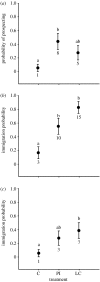Social information trumps vegetation structure in breeding-site selection by a migrant songbird
- PMID: 18559326
- PMCID: PMC2603235
- DOI: 10.1098/rspb.2008.0217
Social information trumps vegetation structure in breeding-site selection by a migrant songbird
Abstract
To maximize fitness, organisms must assess and select suitable habitat. Early research studying birds suggested that organisms consider primarily vegetation structural cues in their habitat choices. We show that experimental exposure to singing in the post-breeding period provides a social cue that is used for habitat selection the following year by a migrant songbird, the black-throated blue warbler (Dendroica caerulescens). Our experimental social cues coerced individuals to adopt territories in areas of very poor habitat quality where individuals typically do not occur. This indicates that social information can override typical associations with vegetation structure. We demonstrate that a strong settlement response was elicited because post-breeding song at a site is highly correlated with reproductive success. These results constitute a previously undocumented, but highly parsimonious mechanism for the inadvertent transfer of reproductive (public) information from successful breeders to dispersers. We hypothesize that post-breeding song is a pervasive and reliable cue for species that communicate vocally, inhabit temporally autocorrelated environments, produce young asynchronously and/or abandon territories after reproductive failure.
Figures




References
-
- Beecher M.D, Burt J.M, O'Loghlen A.L, Templeton C.N, Campbell S.E. Bird song learning in an eavesdropping context. Anim. Behav. 2007;73:929–935. doi:10.1016/j.anbehav.2006.10.013 - DOI
-
- Betts M.G, Hadley A.S, Doran P.J. Avian mobbing response is restricted by territory boundaries: experimental evidence from two species of forest warblers. Ethology. 2005;111:821–835. doi:10.1111/j.1439-0310.2005.01109.x - DOI
-
- Betts M.G, Diamond A.W, Forbes G.J, Villard M.-A, Gunn J.S. The importance of spatial autocorrelation, extent and resolution in predicting forest bird occurrence. Ecol. Model. 2006;191:197–224. doi:10.1016/j.ecolmodel.2005.04.027 - DOI
-
- Boulinier T, Danchin E. The use of conspecific reproductive success for breeding patch selection in terrestrial migratory species. Evol. Ecol. 1997;11:505–517. doi:10.1007/s10682-997-1507-0 - DOI
-
- Broström, G. 2007 TheGLMMMLpackage, v. 0.71-3. See http://cran.r-project.org/src/contrib/Descriptions/glmmML.html
Publication types
MeSH terms
LinkOut - more resources
Full Text Sources

